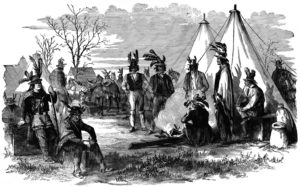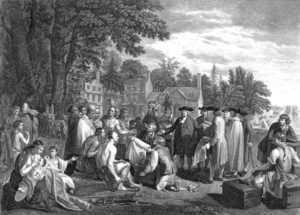 Chiefs of the Iroquois Indians and members of Pennsylvania’s government met on November 5, 1768. They sat down together and negotiated what is now called the Treaty of Fort Stanwix. The agreement opened up the Conemaugh Valley and Stonycreek Valley by encouraging their settlement. When the treaty became effective the following April, a warrant was taken out for 249 acres between Conemaugh and Stonycreek rivers. What was initially an Indian town called Conemaugh eventually grew into Johnstown. It also opened up the shortest land route between Philadelphia and the Great Lakes, which was of interest to merchants.
Chiefs of the Iroquois Indians and members of Pennsylvania’s government met on November 5, 1768. They sat down together and negotiated what is now called the Treaty of Fort Stanwix. The agreement opened up the Conemaugh Valley and Stonycreek Valley by encouraging their settlement. When the treaty became effective the following April, a warrant was taken out for 249 acres between Conemaugh and Stonycreek rivers. What was initially an Indian town called Conemaugh eventually grew into Johnstown. It also opened up the shortest land route between Philadelphia and the Great Lakes, which was of interest to merchants.
The treaty was a turning point in relations between whites and Indians in the region. By that time, the two cultures had been trading for about 40 years. The Treaty of Fort Stanwix marked a formal agreement to settle some land disputes between the two cultures. It also marked the beginning of some problems as formal promises were broken.
Early Contact
Although trade between White men and Indians in the region began in 1728, the White men weren’t living in the area. In fact, pacts that the Penn Family had made with the Indians closed off most of the Allegheny Wilderness from white settlements. White men only came into the area to trade with the Indians.
One of these traders, John Hart, was granted a license to trade with the Indians in 1744. He set up a camp where the Kittanning Indian Trail crossed the Eastern Continental Divide. It was called Hart’s Sleeping Place and “is the first place in Cambria County selected and frequented by while men,” according to the brochure, On the Pioneer Trail in Rural Cambria County.
The Shawonese and Delaware Indians were the principal inhabitants of the Conemaugh Valley, according to Kathy Jones, curator with the Cambria County Historical Society. Henry Wilson Storey also notes in his book, History of Cambria County that while these were the principal tribes, Indians from most of the regional tribes could be found in the area although not in any great numbers.
Records show white settlers considered the Shawonese treacherous and fierce while opinion was split about the Delawares, according to Storey.
“The Delawares were natives of Pennsylvania, and, while they were guilty of many acts of cruelty toward the whites, yet it was probably a matter of self-defense, as their property had been taken from them,” Storey wrote.
The largest point of contention between the Delawares and whites was called “The Walking Purchase” even though it didn’t occur in the Conemaugh and Stonycreek valleys. William Penn’s heirs used a 1686 deed to claim land that the Lenape (or Delawares) had agreed to sell them. The Lenape promised to sell the amount of land from a point near modern-day Easton as far west as a man could walk in a day and a half. The Lenape assumed that the distance would be about 40 miles, but in 1737, John and Thomas Penn arranged for the three fastest runners in the Pennsylvania colony to run the trail. The furthest runner went 70 miles, and the Whites claimed 1.2 million acres.
The whites settlers forced the Lenape to leave the area, and they migrated west with a distrust of white men. Bad interactions like this led to problems.
The Shawonese originally arrived in Pennsylvania from the Carolinas in 1698. The Delawares welcomed them, but even they had trouble with the Shawonese. In 1732, about 700 fighting Indians lived in Pennsylvania and of that number about half were Shawonese.
“Ever restless and quarrelsome themselves, and being encroached upon by the white man, they retired from one hunting ground to another until they joined the French at Pittsburg, in 1755, and finally drifted to the west,” Storey wrote.
You might also enjoy these posts:
One Reply to “The first residents of Johnstown (part 1)”
Comments are closed.